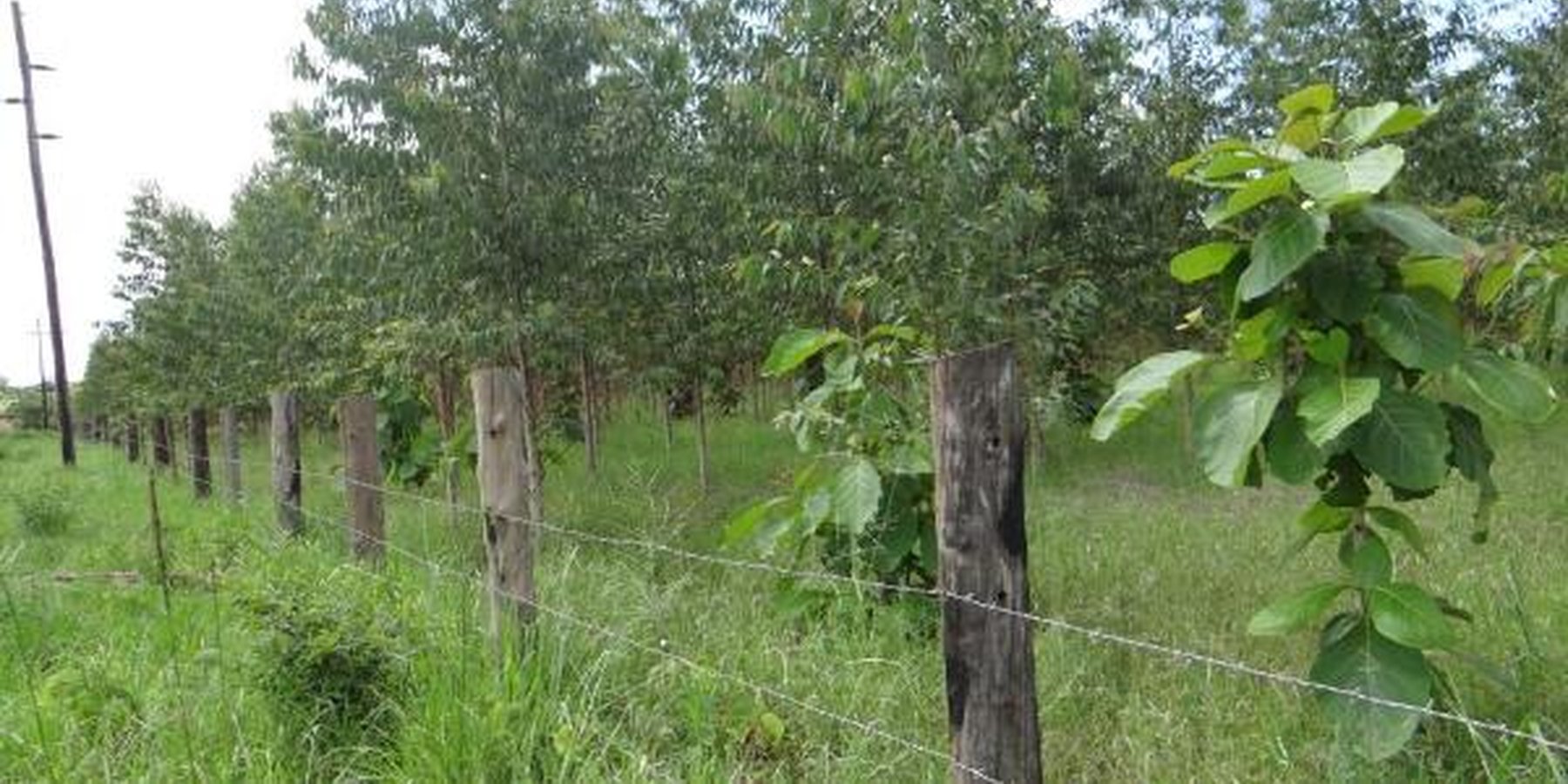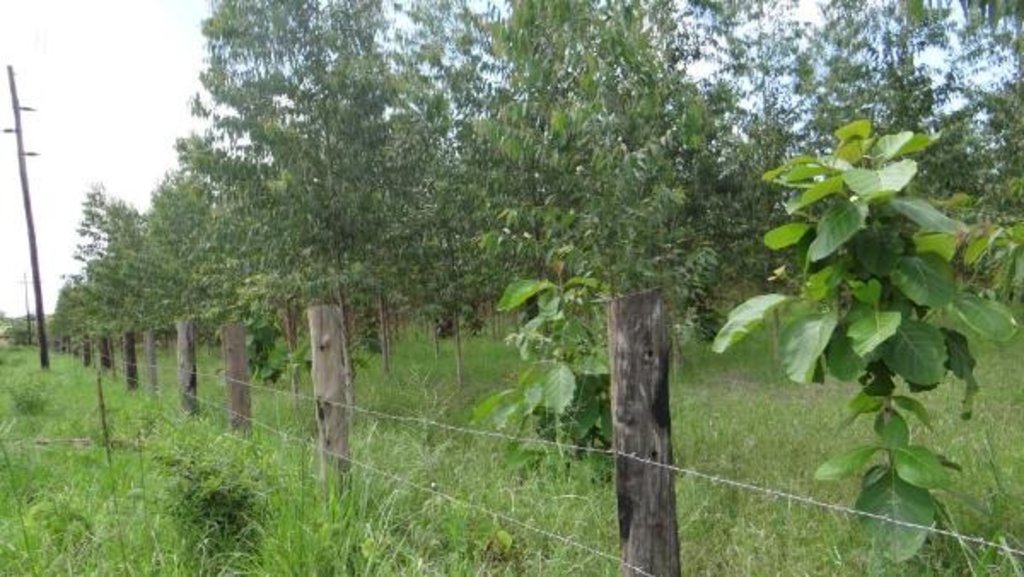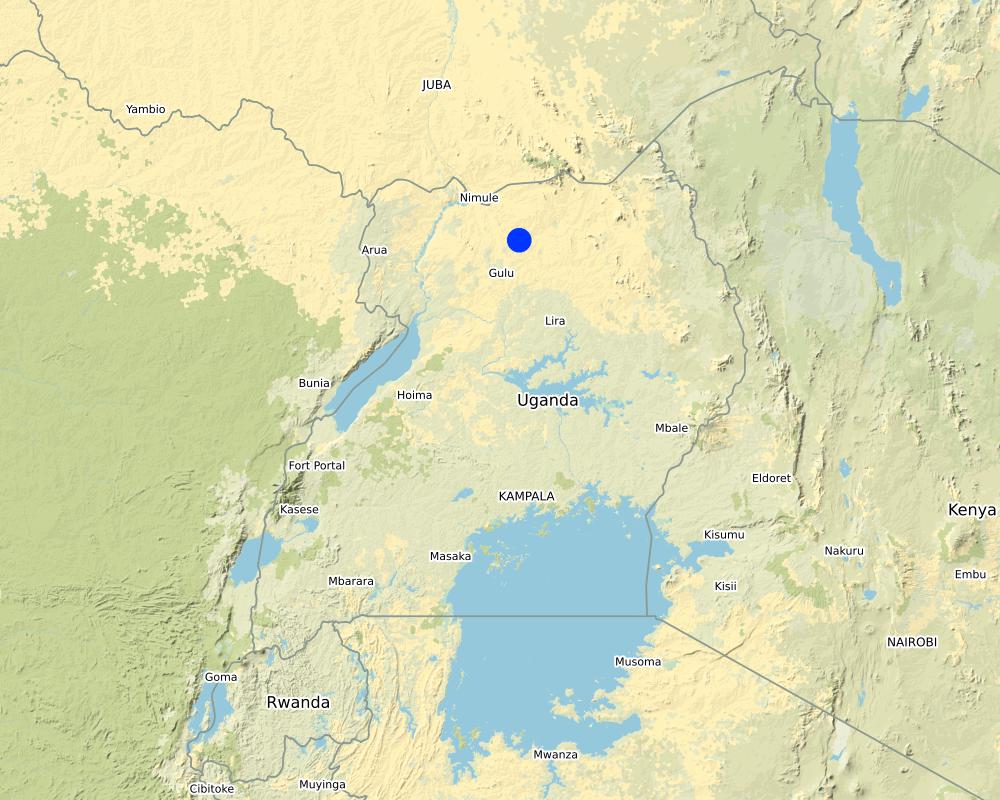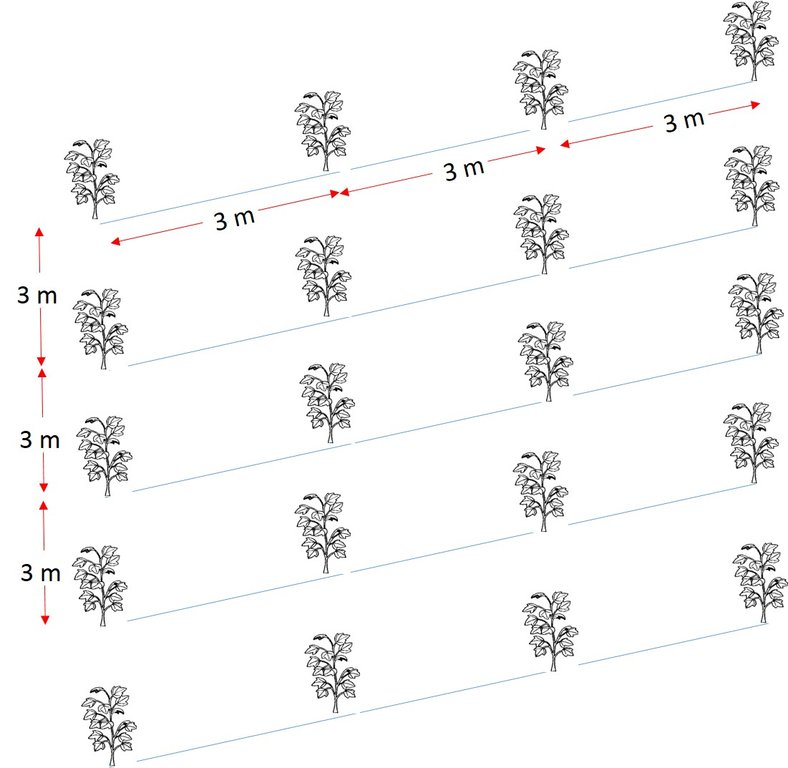Fast-Growing Clonal Eucalyptus [Uganda]
- Creation:
- Update:
- Compiler: Bernard Fungo
- Editors: JOY TUKAHIRWA, Kamugisha Rick Nelson, betty adoch, Sunday Balla Amale
- Reviewers: Drake Mubiru, Nicole Harari, Stephanie Jaquet, Udo Höggel
Pito yen Kalituc
technologies_2870 - Uganda
View sections
Expand all Collapse all1. General information
1.2 Contact details of resource persons and institutions involved in the assessment and documentation of the Technology
Key resource person(s)
land user:
Anywar Francis
+256392962859 / +256753352572
anywarfrancis@gmail.com
Gene Ber Farmer
Lukole village, Olung parish, Agago District
Uganda
Name of project which facilitated the documentation/ evaluation of the Technology (if relevant)
Scaling-up SLM practices by smallholder farmers (IFAD)Name of the institution(s) which facilitated the documentation/ evaluation of the Technology (if relevant)
Bern University of Applied Sciences, School of Agricultural, Forest and Food Sciences (HAFL) - Switzerland1.3 Conditions regarding the use of data documented through WOCAT
When were the data compiled (in the field)?
11/05/2017
The compiler and key resource person(s) accept the conditions regarding the use of data documented through WOCAT:
Yes
1.4 Declaration on sustainability of the described Technology
Is the Technology described here problematic with regard to land degradation, so that it cannot be declared a sustainable land management technology?
No
2. Description of the SLM Technology
2.1 Short description of the Technology
Definition of the Technology:
Clonal eucalyptus trees (originating from South Africa) grow in northern Uganda for timber production
2.2 Detailed description of the Technology
Description:
Clonal eucalyptus, commonly known as a hybrid of eucalyptus species developed by crossing various species of eucalyptus. It is fast-growing, attaining maturity for timber between 12 to15 years.
Seedlings for the eucalyptus clones are sold by various tree nursery operators in the area from where the farmers buy them. In preparation for tree planting, the land is cleared of all vegetation usually by slashing, but use of herbicides is also possible. Planting holes, measuring 30cm in diameter and depth, are dug at a spacing of 3m x 3m. Seedlings of 1-2 months age, bought from nurseries are planted in the prepared holes. Weeding is done twice a year for the first two years during which maize and beans can be intercropped with the young trees. Intercropping young trees with crops, a practice known as 'Taungya', helps to compensate for the weeding costs. Eucalyptus trees are generally self-pruning but if need arises, branches that have grown larger than 6 cm in diameter are removed using a saw. Pruning becomes necessary at the age of 3 years. At planting, the number of plants is 1,100 per hectare. Thinning is usually done at the age of 4 and 7 years, leaving about 450 plants per hactare. Protecting from animals and fire and is also done periodically by patrolling and creating fire lines in the plantation. The fire lines are created by dividing the plantation into smaller units and clearing 6-m wide strips between the units.
Farmers like the eucalyptus clones for establishing timber plantations because they grow fast and yield timber 5 to 7 years earlier than the non-hybrid species thus reducing the payback period for eucalyptus plantations. They are a source of income through the sale of poles and help in carbon sequestration which reduces the effect of climate change.
Farmers are apprehensive of this technology because the appropriate clones are difficult to locate in the tree nurseries. Secondly, some nursery operators do not tell the truth about the performance of different clones in the area. In northern Uganda, the most adaptable clone is 'GC 784', which has been observed to perform exceptionally well. The cost of the hybrid clones is 40% higher than the conventional seedlings.
2.3 Photos of the Technology
2.4 Videos of the Technology
Date:
10/5/2017
Location:
Agago District
2.5 Country/ region/ locations where the Technology has been applied and which are covered by this assessment
Country:
Uganda
Region/ State/ Province:
Northern
Map
×2.6 Date of implementation
Indicate year of implementation:
2015
2.7 Introduction of the Technology
Specify how the Technology was introduced:
- through land users' innovation
3. Classification of the SLM Technology
3.1 Main purpose(s) of the Technology
- reduce risk of disasters
- create beneficial economic impact
3.2 Current land use type(s) where the Technology is applied

Cropland
- Annual cropping
Main crops (cash and food crops):
Millet, Maize, Beans
3.3 Further information about land use
Water supply for the land on which the Technology is applied:
- rainfed
Number of growing seasons per year:
- 2
Specify:
March-June and September-December
3.4 SLM group to which the Technology belongs
- forest plantation management
3.5 Spread of the Technology
Specify the spread of the Technology:
- evenly spread over an area
If the Technology is evenly spread over an area, indicate approximate area covered:
- < 0.1 km2 (10 ha)
3.6 SLM measures comprising the Technology

vegetative measures
- V3: Clearing of vegetation
- V4: Replacement or removal of alien/ invasive species
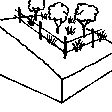
management measures
- M3: Layout according to natural and human environment
3.7 Main types of land degradation addressed by the Technology

biological degradation
- Bc: reduction of vegetation cover
3.8 Prevention, reduction, or restoration of land degradation
Specify the goal of the Technology with regard to land degradation:
- prevent land degradation
- adapt to land degradation
4. Technical specifications, implementation activities, inputs, and costs
4.1 Technical drawing of the Technology
4.2 Technical specifications/ explanations of technical drawing
Spacing of 3 x 3 meters between and within rows
Panting density of 1100 tree per ha
Thinning to 450 tree per ha around year 7
4.3 General information regarding the calculation of inputs and costs
Specify how costs and inputs were calculated:
- per Technology unit
Specify unit:
Hectares
other/ national currency (specify):
Uganda Shillings
Indicate exchange rate from USD to local currency (if relevant): 1 USD =:
3500.0
Indicate average wage cost of hired labour per day:
10,000
4.4 Establishment activities
| Activity | Type of measure | Timing | |
|---|---|---|---|
| 1. | Land clearing | Management | |
| 2. | Liming-out and pitting | Management | |
| 3. | Planting | Agronomic | |
| 4. | Weeding | Management | |
| 5. | Thinning | Management |
4.5 Costs and inputs needed for establishment
| Specify input | Unit | Quantity | Costs per Unit | Total costs per input | % of costs borne by land users | |
|---|---|---|---|---|---|---|
| Labour | Land cleaing | Hactares | 40.0 | 200003.0 | 8000120.0 | 100.0 |
| Labour | Lining-out and pitting | Hactares | 40.0 | 200000.0 | 8000000.0 | 100.0 |
| Labour | Planting | Hactares | 40.0 | 200000.0 | 8000000.0 | 100.0 |
| Labour | Weeding | Hactares | 40.0 | 200000.0 | 8000000.0 | 100.0 |
| Equipment | Thinning | Hactares | 40.0 | 400000.0 | 16000000.0 | 100.0 |
| Plant material | Seedlings | Number | 1100.0 | 500.0 | 550000.0 | 100.0 |
| Total costs for establishment of the Technology | 48550120.0 | |||||
4.6 Maintenance/ recurrent activities
| Activity | Type of measure | Timing/ frequency | |
|---|---|---|---|
| 1. | Periodic Patrols | Management | Monthly |
4.7 Costs and inputs needed for maintenance/ recurrent activities (per year)
| Specify input | Unit | Quantity | Costs per Unit | Total costs per input | % of costs borne by land users | |
|---|---|---|---|---|---|---|
| Labour | Patrols | Years | 10.0 | 500000.0 | 5000000.0 | 100.0 |
| Total costs for maintenance of the Technology | 5000000.0 | |||||
4.8 Most important factors affecting the costs
Describe the most determinate factors affecting the costs:
Buying seedlings
5. Natural and human environment
5.1 Climate
Annual rainfall
- < 250 mm
- 251-500 mm
- 501-750 mm
- 751-1,000 mm
- 1,001-1,500 mm
- 1,501-2,000 mm
- 2,001-3,000 mm
- 3,001-4,000 mm
- > 4,000 mm
Agro-climatic zone
- sub-humid
5.2 Topography
Slopes on average:
- flat (0-2%)
- gentle (3-5%)
- moderate (6-10%)
- rolling (11-15%)
- hilly (16-30%)
- steep (31-60%)
- very steep (>60%)
Landforms:
- plateau/plains
- ridges
- mountain slopes
- hill slopes
- footslopes
- valley floors
Altitudinal zone:
- 0-100 m a.s.l.
- 101-500 m a.s.l.
- 501-1,000 m a.s.l.
- 1,001-1,500 m a.s.l.
- 1,501-2,000 m a.s.l.
- 2,001-2,500 m a.s.l.
- 2,501-3,000 m a.s.l.
- 3,001-4,000 m a.s.l.
- > 4,000 m a.s.l.
Indicate if the Technology is specifically applied in:
- not relevant
5.3 Soils
Soil depth on average:
- very shallow (0-20 cm)
- shallow (21-50 cm)
- moderately deep (51-80 cm)
- deep (81-120 cm)
- very deep (> 120 cm)
Soil texture (topsoil):
- medium (loamy, silty)
Soil texture (> 20 cm below surface):
- medium (loamy, silty)
Topsoil organic matter:
- medium (1-3%)
5.4 Water availability and quality
Ground water table:
5-50 m
Availability of surface water:
medium
Water quality (untreated):
for agricultural use only (irrigation)
Is water salinity a problem?
No
Is flooding of the area occurring?
No
5.5 Biodiversity
Species diversity:
- medium
Habitat diversity:
- medium
5.6 Characteristics of land users applying the Technology
Sedentary or nomadic:
- Sedentary
Market orientation of production system:
- commercial/ market
Off-farm income:
- 10-50% of all income
Relative level of wealth:
- average
Individuals or groups:
- individual/ household
Level of mechanization:
- manual work
Gender:
- men
Age of land users:
- middle-aged
5.7 Average area of land owned or leased by land users applying the Technology
- < 0.5 ha
- 0.5-1 ha
- 1-2 ha
- 2-5 ha
- 5-15 ha
- 15-50 ha
- 50-100 ha
- 100-500 ha
- 500-1,000 ha
- 1,000-10,000 ha
- > 10,000 ha
Is this considered small-, medium- or large-scale (referring to local context)?
- medium-scale
5.8 Land ownership, land use rights, and water use rights
Land ownership:
- individual, not titled
Land use rights:
- individual
Water use rights:
- individual
5.9 Access to services and infrastructure
health:
- poor
- moderate
- good
education:
- poor
- moderate
- good
technical assistance:
- poor
- moderate
- good
employment (e.g. off-farm):
- poor
- moderate
- good
markets:
- poor
- moderate
- good
energy:
- poor
- moderate
- good
roads and transport:
- poor
- moderate
- good
drinking water and sanitation:
- poor
- moderate
- good
financial services:
- poor
- moderate
- good
6. Impacts and concluding statements
6.1 On-site impacts the Technology has shown
Socio-economic impacts
Production
wood production
energy generation
Ecological impacts
Biodiversity: vegetation, animals
Vegetation cover
biomass/ above ground C
6.2 Off-site impacts the Technology has shown
wind transported sediments
6.3 Exposure and sensitivity of the Technology to gradual climate change and climate-related extremes/ disasters (as perceived by land users)
Climate-related extremes (disasters)
Climatological disasters
| How does the Technology cope with it? | |
|---|---|
| heatwave | well |
6.4 Cost-benefit analysis
How do the benefits compare with the establishment costs (from land users’ perspective)?
Short-term returns:
slightly positive
Long-term returns:
very positive
How do the benefits compare with the maintenance/ recurrent costs (from land users' perspective)?
Short-term returns:
positive
Long-term returns:
very positive
6.5 Adoption of the Technology
- 1-10%
Of all those who have adopted the Technology, how many have did so spontaneously, i.e. without receiving any material incentives/ payments?
- 90-100%
6.6 Adaptation
Has the Technology been modified recently to adapt to changing conditions?
No
6.7 Strengths/ advantages/ opportunities of the Technology
| Strengths/ advantages/ opportunities in the land user’s view |
|---|
| Income |
| Timber |
| Strengths/ advantages/ opportunities in the compiler’s or other key resource person’s view |
|---|
| Eucalyptus clones have a shorter pay-back period compared to native species |
6.8 Weaknesses/ disadvantages/ risks of the Technology and ways of overcoming them
| Weaknesses/ disadvantages/ risks in the land user’s view | How can they be overcome? |
|---|---|
| The timber from eucalyptus clones has yet to be adequately tested for strength | Research |
| Risk of fire is very high in the area. Clones are highly susceptible. | Ensure the plantation is protected from fire by use of fire lines and frequent patrols |
| Weaknesses/ disadvantages/ risks in the compiler’s or other key resource person’s view | How can they be overcome? |
|---|---|
| Establishment cost | |
| Weeding |
7. References and links
7.1 Methods/ sources of information
- field visits, field surveys
1
- interviews with land users
1
- interviews with SLM specialists/ experts
2
7.2 References to available publications
Title, author, year, ISBN:
N/a
7.3 Links to relevant information which is available online
Title/ description:
N/a
Links and modules
Expand all Collapse allLinks
No links
Modules
No modules


